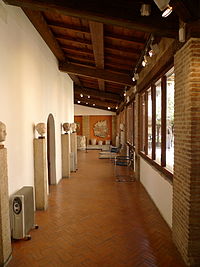Archaeological Museum in the Roman Theater
 View into an exhibition room |
|
| Data | |
|---|---|
| place | Regaste Redentore, Verona |
| Art |
Archaeological Museum
|
| opening | 1923 |
| operator |
Verona municipality
|
| Website | |
The Archaeological Museum in the Roman Theater (it. Museo archeologico al teatro romano ) is a museum in Verona . It is located above the Teatro Romano di Verona , in the former monastery of St. Jerome the Jesuits .
history
Around 1430 the Jesuats settled on the hill of S. Pietro, which is rich in spring water. At the top of the hill above the Roman theater, the monks built the monastery, which spreads out on a wide terrace.
In 1923, the city of Verona set up the Archaeological Museum in the former monastery to collect and display ancient finds from Verona and the surrounding area.
The exhibition
In the hall next to the elevator, two panels of the mosaic floor of a Roman villa in Negrar , which can be dated to the 3rd century AD and show a mythological scene and a chariot pulled by a putto, are placed on the wall . Among the sculptures is the portrait of a member of the imperial Julio-Claudian family found in Verona . Etruscan and Roman bronze figures are exhibited in the former monastery cells , a double-faced woman's head, the luxurious furnishings of a Veronese house, glasses and Roman ceramics from the Verona area and a bronze portrait of a noble Veronese from the Augustan period.
In the refectory there is a seated female figure, the head of which has not been preserved. She is dressed in a tunic and a coat. The marble sculpture is (possibly) a Roman copy of Aphrodite des Phidias . The walls of the hall were all painted with frescoes . You can see the remains of the “ Last Supper ” by Giovanni Francesco Caroto on the back wall and the figure of a Jesus on the side wall.
In the cloister are inscriptions issued especially grave inscriptions from Verona. The chapel of St. Jerome, painted by Caroto in 1508, has a flat vault "alla gesuata" made of wooden panels decorated with leafy branches or with shields arranged around a rose window .
In the lower room there are inscriptions dedicated to the Roman gods. You can see, among other things, the cavity (18 m deep) that the Romans used to separate the hill from the auditorium to prevent water from seeping in.
Exhibits
Access
Access to the museum is through the Roman theater. Above the staircase to the auditorium of the Roman theater, an elevator leads to the former monastery. Another entrance is a staircase in the western area of the theater.





